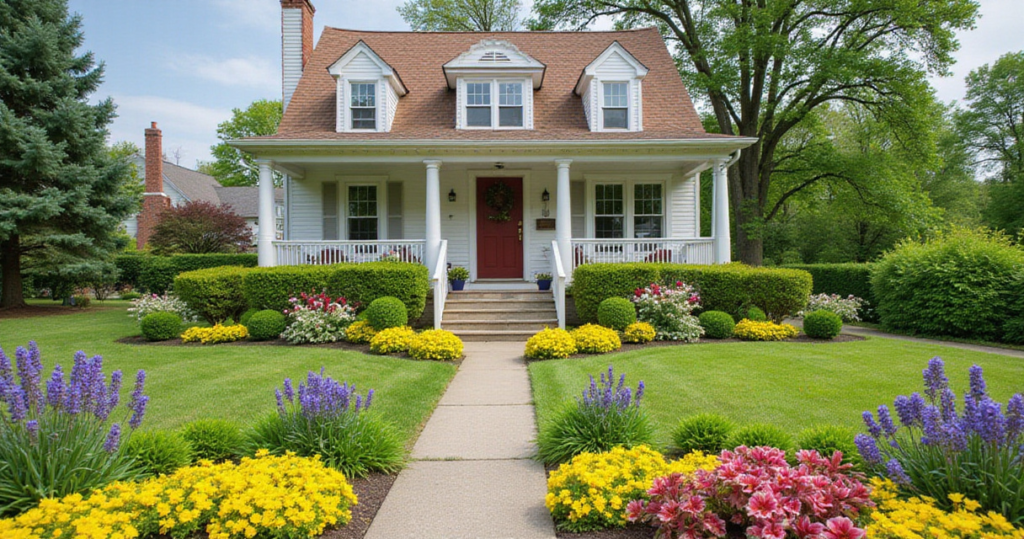The front yard serves as your home’s first impression—a canvas where nature and architecture meet. Unlike the private sanctuary of a backyard, this space exists in dialogue with your neighborhood, silently communicating your values and aesthetic sensibilities to passersby.
When approached with intention, front Yard Landscaping becomes more than mere decoration. It creates a harmonious transition between public and private realms, guiding visitors toward your entrance while establishing a sense of place. Even modest changes can dramatically transform this vital space, enhancing not just appearance but also the daily experience of arriving home.
The inspiration for this collection emerged from observing how traditional Japanese gardens achieve balance through careful placement rather than abundance. Each element serves a purpose—whether functional, visual, or spiritual—creating a whole greater than its parts.
1. Cultivate Seasonal Rhythm with Flowering Plants
Flowers bring more than color to front yard landscaping—they introduce a living, breathing element that shifts with the seasons. Like the transient beauty of cherry blossoms celebrated in hanami festivals, flowering plants remind us of nature’s cycles and impermanence.
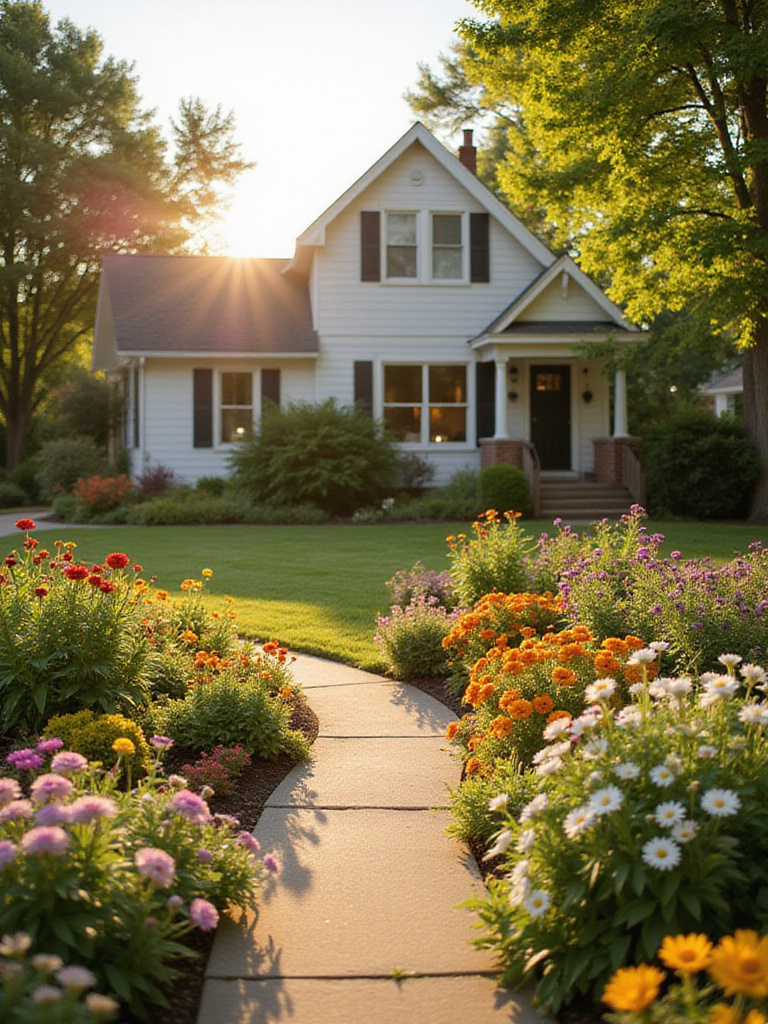
Choose varieties that offer sequential blooming periods, creating a garden that evolves throughout the year. Consider native flowering plants that have adapted to your local climate conditions, requiring less intervention while supporting local pollinators. The true art lies in arranging these elements so they create natural focal points that draw the eye through your landscape, much like a carefully composed painting.
- Plant low-maintenance perennials like echinacea or black-eyed Susans for reliable summer color
- Include early-blooming bulbs such as snowdrops or crocus to welcome spring
- Add late-season bloomers like asters or Japanese anemone for autumn interest
The concept of shakkei or “borrowed scenery” suggests we look beyond our immediate space. As you choose flowering plants, consider how their colors might complement distant views or architectural elements.
2. Design Pathways That Honor Movement and Pause
A thoughtfully designed walkway does more than connect points—it choreographs the experience of moving through space. In traditional Japanese gardens, paths often meander rather than proceed directly, encouraging mindful walking and moments of discovery.
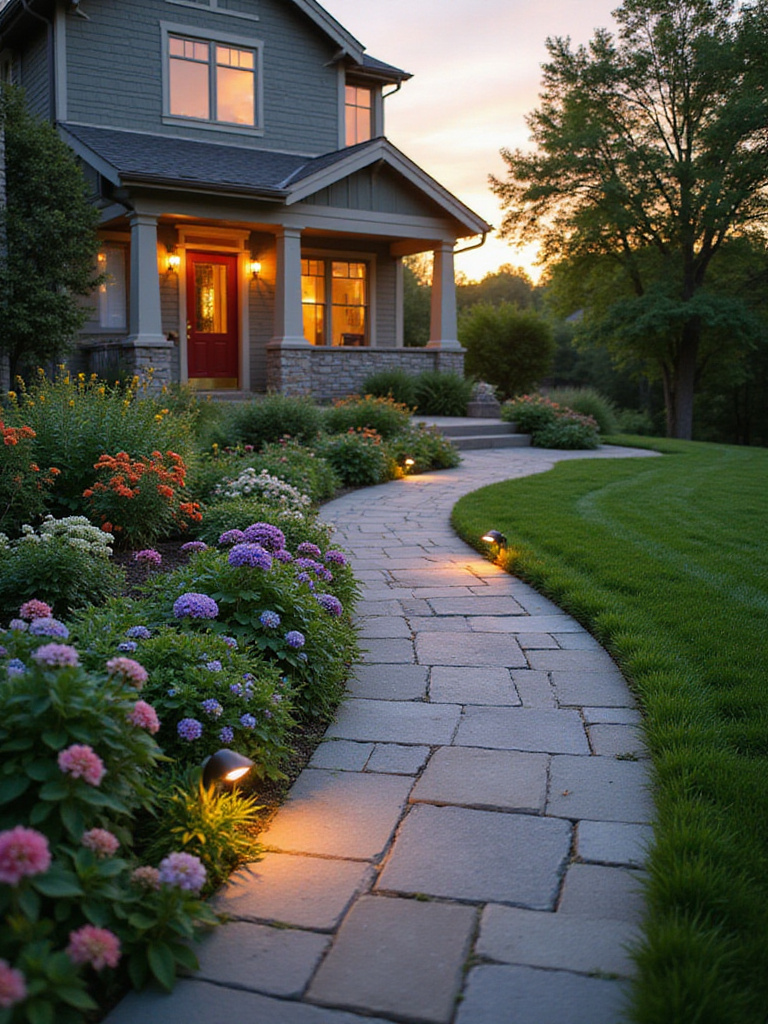
Consider how your front path might create a journey rather than merely a route. A slight curve invites visitors to slow their pace and notice surroundings, while varying materials can signal transitions between different areas. The width of your path also influences experience—narrow sections encourage individual contemplation while wider areas allow for shared moments.
- Use irregular stepping stones surrounded by moss or ground cover for a naturalistic approach
- Incorporate subtle lighting that illuminates the path without overwhelming the night sky
- Consider how the path sounds underfoot—the gentle crunch of gravel can add sensory richness
The interplay between movement and stillness creates rhythm in front yard landscaping. After guiding visitors along a path, what moment of arrival or discovery awaits them?
3. Balance Light and Shadow with Thoughtful Illumination
Lighting in front yard landscaping extends beyond safety and security—it sculpts space after sunset, creating a nocturnal landscape of gentle highlights and mysterious shadows. This interplay between light and darkness, known as in-ei in Japanese aesthetics, adds depth and subtlety to your outdoor space.
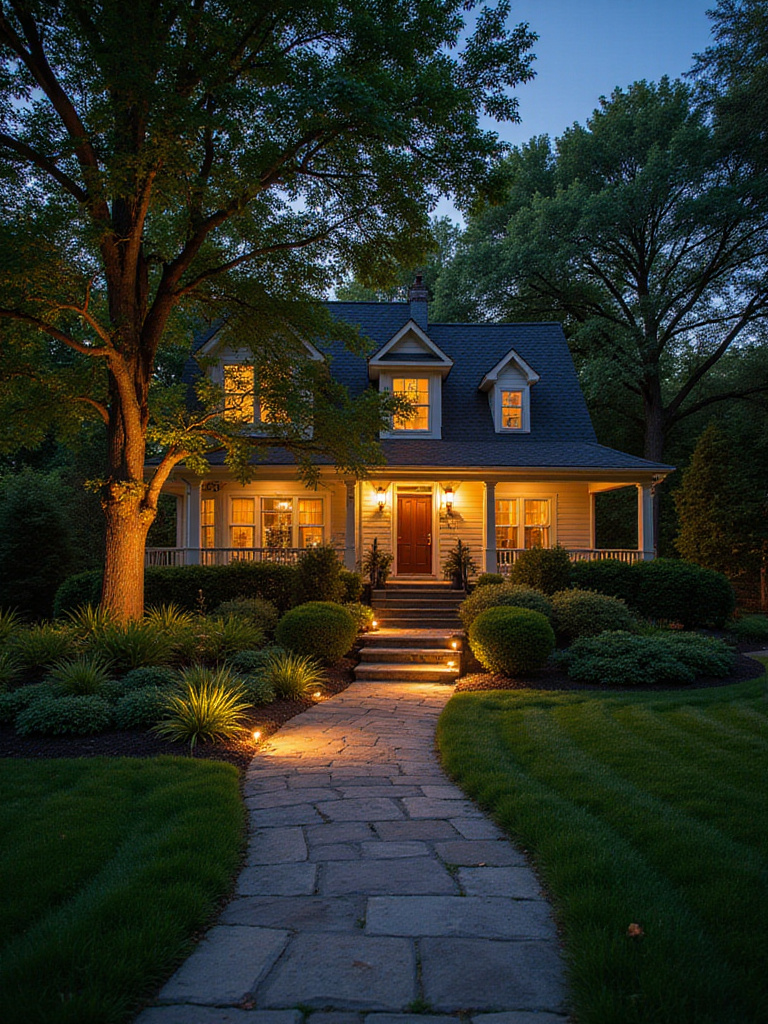
Rather than flooding the area with brightness, consider a restrained approach that highlights key elements while allowing darkness its proper place. Uplighting a distinctive tree creates dramatic shadows on walls, while path lights can create pools of illumination that guide movement without revealing everything at once. Solar options now offer sophisticated designs that harmonize with natural surroundings.
- Place lights at varying heights to create dimensional layers
- Use warm-toned bulbs (2700-3000K) that complement plant materials
- Consider moonlighting effects by placing fixtures high in trees
As daylight fades, illumination transforms your front yard into a different space entirely. This transition mirrors another essential element of thoughtful landscaping—the vertical dimension provided by trees.
4. Anchor Your Landscape with a Thoughtfully Placed Tree
A single, well-chosen tree brings a sense of permanence and living presence to front yard landscaping that no other element can match. Like an elder watching over the space, a tree connects your home to both earth and sky while marking the passage of seasons and years.
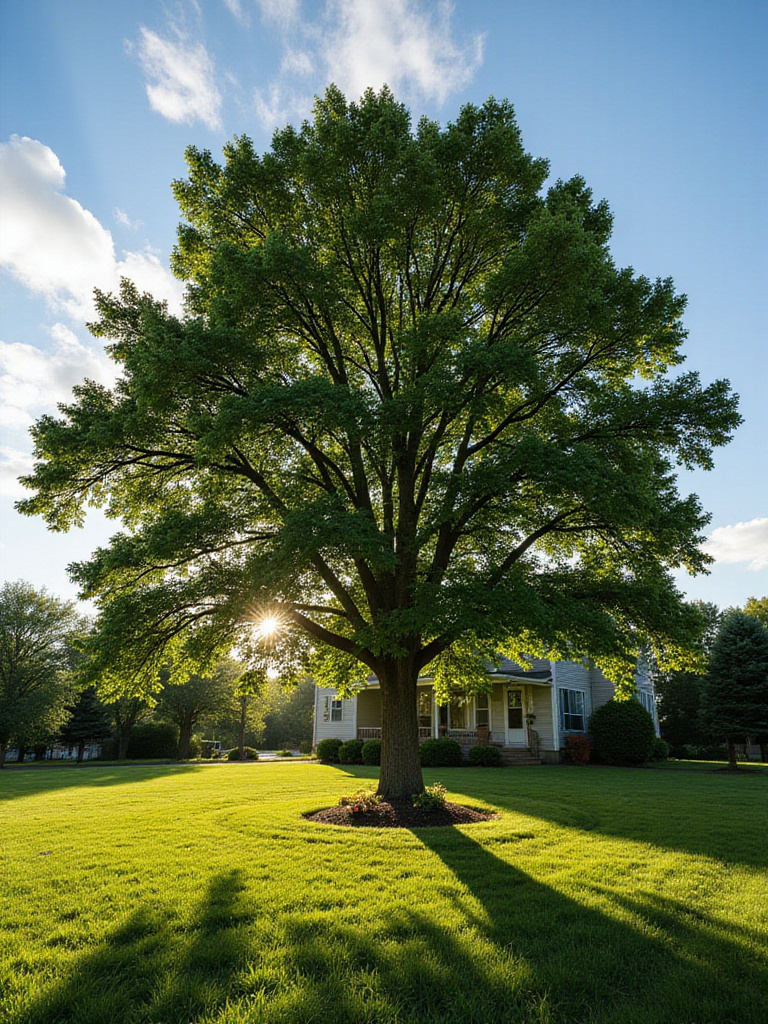
When selecting a tree, consider its relationship with your home’s architecture. A vertical species might emphasize a tall facade, while a spreading canopy can soften angular lines. Think beyond the young sapling to envision its mature form decades hence—a practice in long-term thinking often missing in contemporary design. The Japanese concept of ma (negative space) reminds us that the open areas around a tree are as important as the tree itself.
- Consider small ornamental trees like Japanese maple or dogwood for modest spaces
- Plant deciduous trees on southern exposures for summer shade and winter sunlight
- Look for species with multiple seasons of interest through bark, fruit, or fall color
“The best time to plant a tree was twenty years ago. The second best time is now.” — Chinese proverb
The vertical element of trees naturally leads us to consider how other materials might add structural interest to the horizontal plane of your front yard.
5. Embrace Wabi-Sabi Through Stone Arrangements
Stone brings an element of permanence and geological time to front yard landscaping. Unlike plants that grow and change, rocks offer stability and enduring presence. The Japanese principle of wabi-sabi—finding beauty in imperfection and transience—guides us to appreciate the weathered surfaces, irregular shapes, and subtle colorations of natural stone.
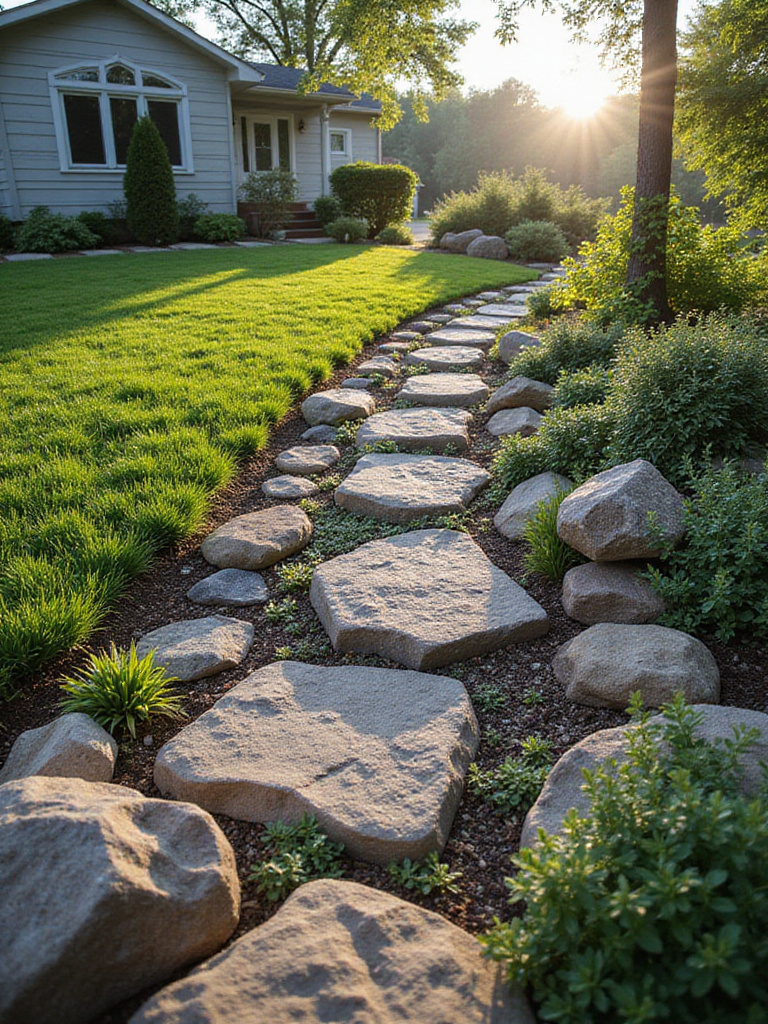
When incorporating rocks into your landscape, resist the urge for perfect symmetry or artificial arrangements. Instead, place stones as if they emerged naturally from the earth, partially buried and settled over time. Group them in odd numbers, varying sizes while maintaining visual relationship between pieces. Allow moss or small plants to grow among them, softening edges and suggesting the passage of time.
- Choose local stone varieties that connect your landscape to regional geology
- Place larger stones partially buried to appear more naturally integrated
- Consider how stones catch light and cast shadows throughout the day
The solidity of stone creates a compelling contrast with the fluid movement of water—another element that brings multisensory richness to front yard landscaping.
6. Invite Reflection with Water Features
Water introduces a contemplative quality to front yard landscaping that transforms the atmosphere entirely. Beyond visual appeal, the sound of moving water masks urban noise while creating a sense of coolness and tranquility. In Japanese gardens, even small water elements hold symbolic significance, representing the flow of life and the passage of time.
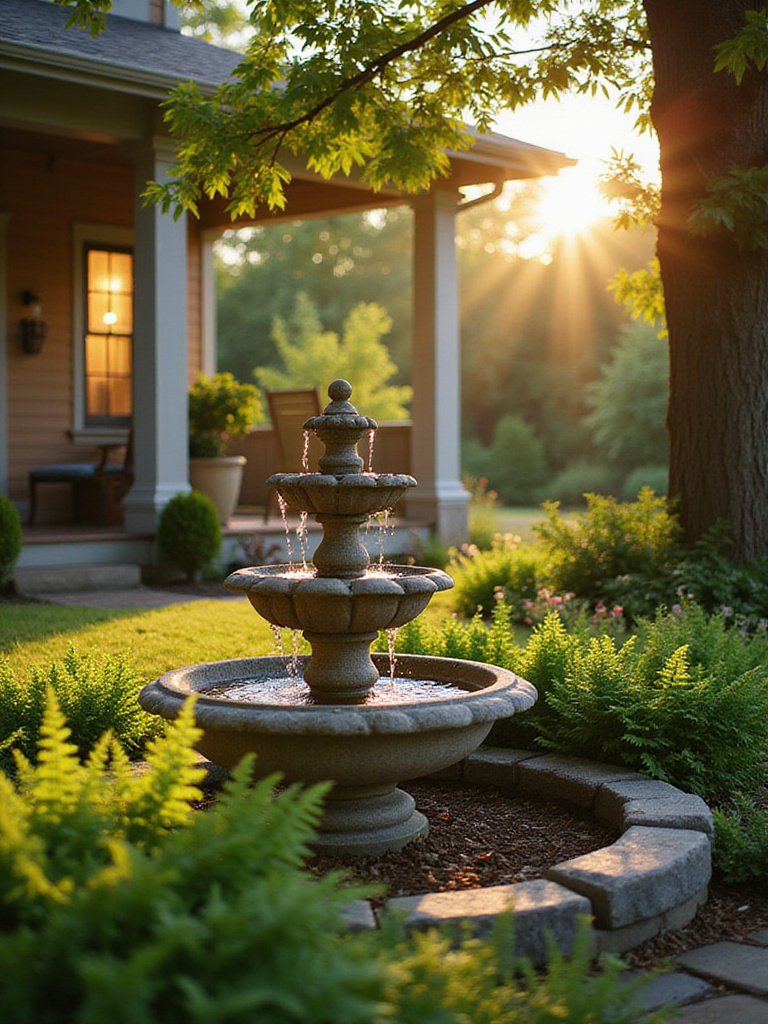
Scale your water feature appropriately to your space—sometimes a simple ceramic basin with a bamboo spout creates more impact than an elaborate fountain. Consider how the water element relates to other landscape components, perhaps reflecting the sky or nearby plantings. The sound quality deserves equal attention to visual design, as different water movements create distinctive auditory experiences.
- Install a small tsukubai (water basin) near the entrance for both symbolism and practicality
- Consider a dry stream bed with occasional water during rain for low-maintenance suggestion of water
- Use dark-bottomed containers to create reflective surfaces that mirror the sky
“In still water, one sees one’s own face; in moving water, one sees the nature of time.”
The reflective quality of water naturally complements another element of thoughtful front yard landscaping—areas designed for human presence and contemplation.
7. Create Ma (Negative Space) with Intentional Seating
Incorporating a seating area in front yard landscaping acknowledges that gardens are meant not just for viewing but for experiencing. The Japanese concept of ma—the meaningful emptiness between objects—applies perfectly to these spaces, which serve as pauses in the landscape where one can be present and observant.
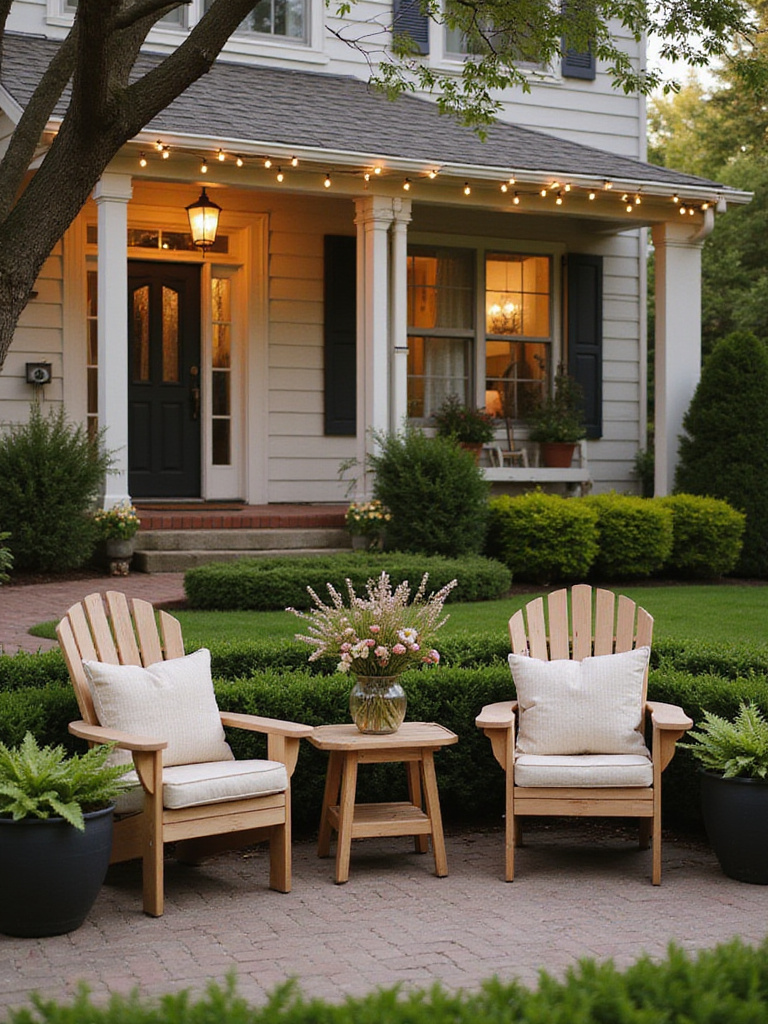
Position seating to frame particular views or create a sense of enclosure without complete isolation from the street. Consider the quality of experience in different seasons and times of day—morning sun in spring might be welcome, while afternoon shade becomes essential in summer. Materials should weather gracefully, developing patina rather than deterioration over time.
- Place a simple bench beneath a tree for dappled shade
- Create a small gravel “island” with two chairs for morning coffee
- Consider built-in seating incorporated into retaining walls or planters
The thoughtful pause created by seating areas complements the defined edges that give structure to front yard landscaping.
8. Define Boundaries with Intentional Edging
The places where different elements meet—lawn against garden bed, gravel against plantings—deserve as much consideration as the elements themselves. In Japanese aesthetics, these transitions are never casual but carefully articulated, creating clean lines that bring order to natural forms.
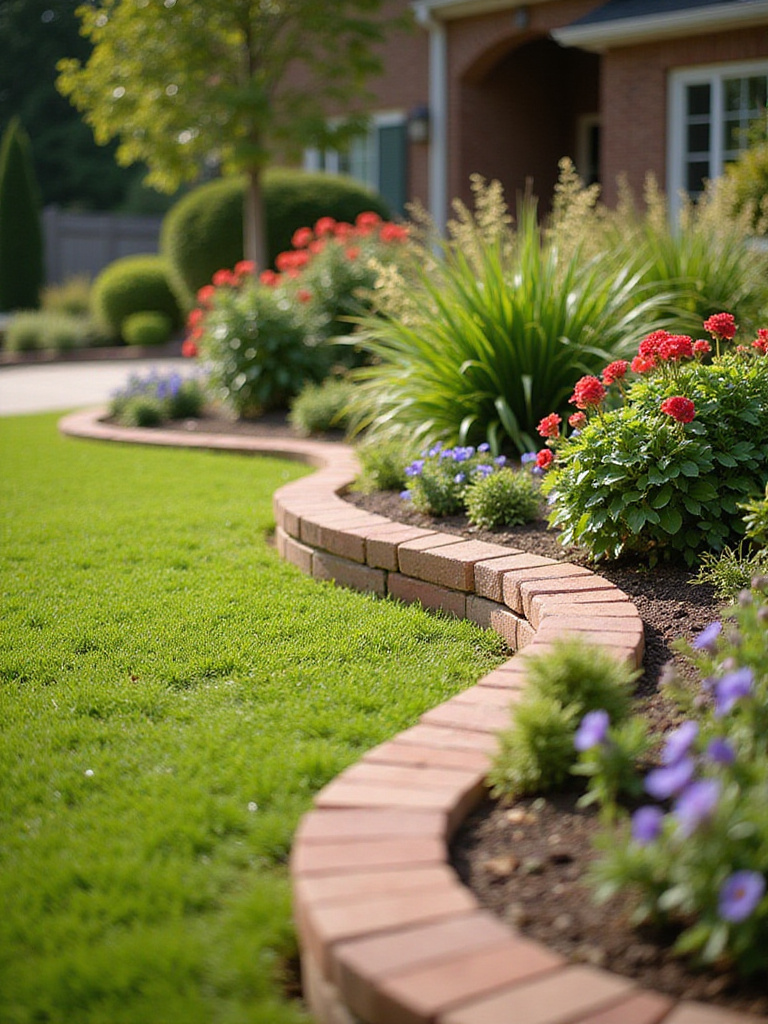
Edging materials should complement your overall design language while serving the practical function of containing soil and mulch. Consider how these boundaries will age over time—will they maintain their definition or soften gradually? The height of edging also influences perception—flush borders create subtle definition while raised edges make more pronounced statements.
- Use steel edging for contemporary designs requiring crisp, minimal lines
- Consider natural stone borders that relate to other stone elements in the landscape
- Explore living edges with compact plants like boxwood or germander for traditional settings
The clean definition provided by thoughtful edging transitions naturally to another approach to front yard landscaping—replacing traditional lawns with lower-maintenance alternatives.
9. Honor Simplicity with Ground Cover Alternatives
The expansive lawn, while traditional in American front yard landscaping, often demands resources disproportionate to its functional value. Ground covers offer thoughtful alternatives that require less water, mowing, and chemical intervention while providing visual interest through texture and seasonal change.
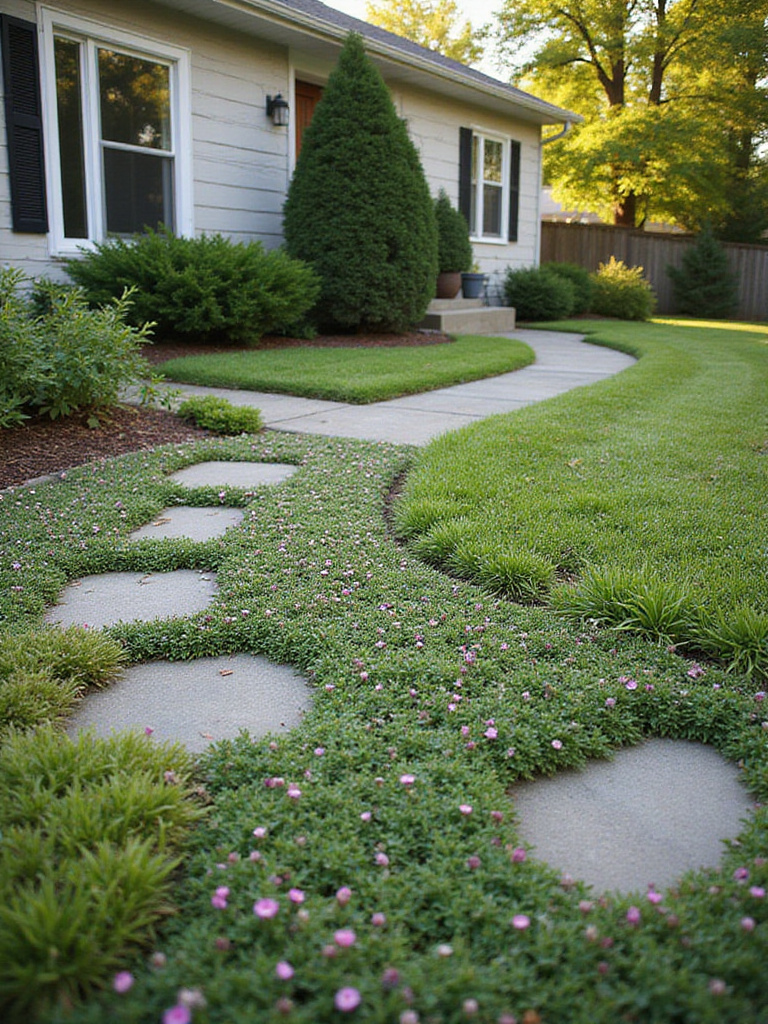
Select ground covers based on your specific conditions—sun exposure, foot traffic, and climate considerations all influence which varieties will thrive. Consider creating a tapestry of different species rather than a monoculture, allowing each to find its natural boundaries. This approach honors the Japanese principle of shizen—allowing nature to express itself within a framework of human intention.
- Plant creeping thyme between stepping stones for fragrance when walked upon
- Use sedges or low-growing native grasses for movement and texture
- Consider moss gardens in shaded areas for an atmosphere of tranquility and age
The textural richness of ground covers complements the structural elements provided by carefully selected shrubs and hedges.
10. Frame Views with Structural Plantings
Shrubs and hedges function as the architectural elements of front yard landscaping, creating volume, structure, and definition. Like the carefully pruned forms in Japanese gardens, these plants can be shaped to frame views, create thresholds, or establish rhythmic patterns across the landscape.
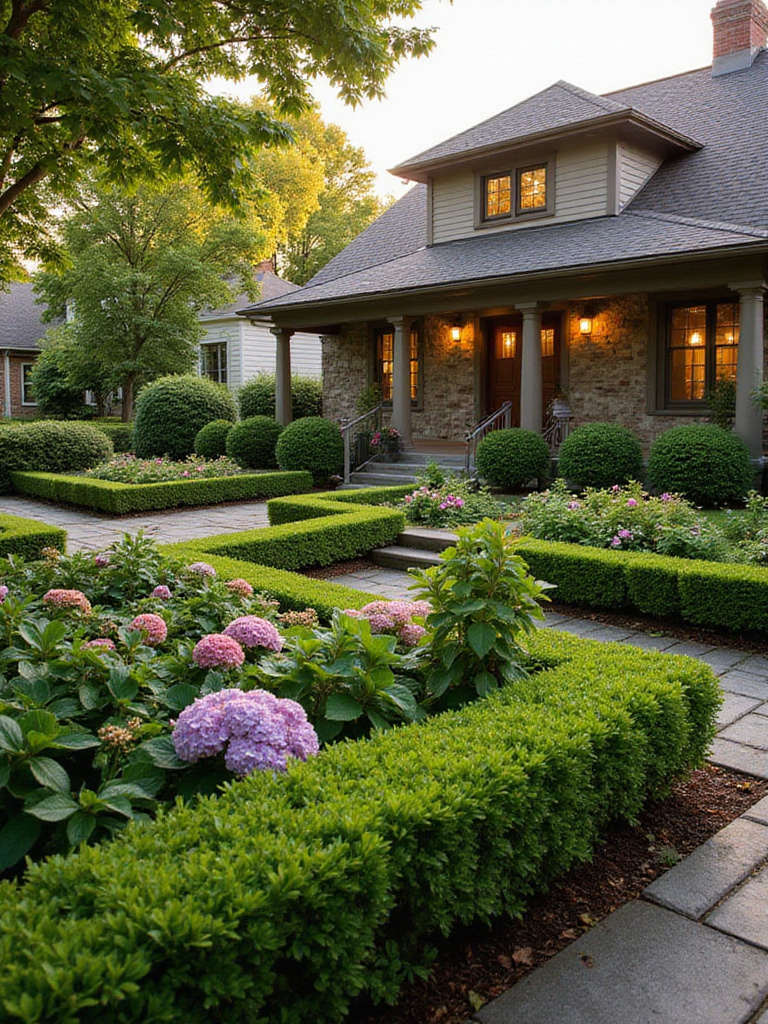
Select varieties with consideration for their natural growth habits—fighting against a plant’s inherent form requires constant intervention and rarely achieves harmony. Consider how these structural elements will appear through seasonal changes. Evergreens provide consistent form while deciduous shrubs offer evolving interest through foliage, flowers, and sometimes winter branch patterns.
- Use niwaki (garden trees) techniques for cloud-pruned specimens that create focal points
- Plant low hedges to define different garden rooms or functions
- Consider shrubs with multiple seasons of interest through berries, bark, or fall color
The deliberate structure created by shrubs establishes a framework within which smaller details can shine—like the humble mailbox transformed into a design element.
11. Transform Utility into Beauty Through Mindful Details
Even utilitarian elements like mailboxes deserve thoughtful integration into front yard landscaping. The Japanese concept of mingei celebrates the beauty of functional objects made with care and intention—a principle that can transform everyday features from afterthoughts into highlights.
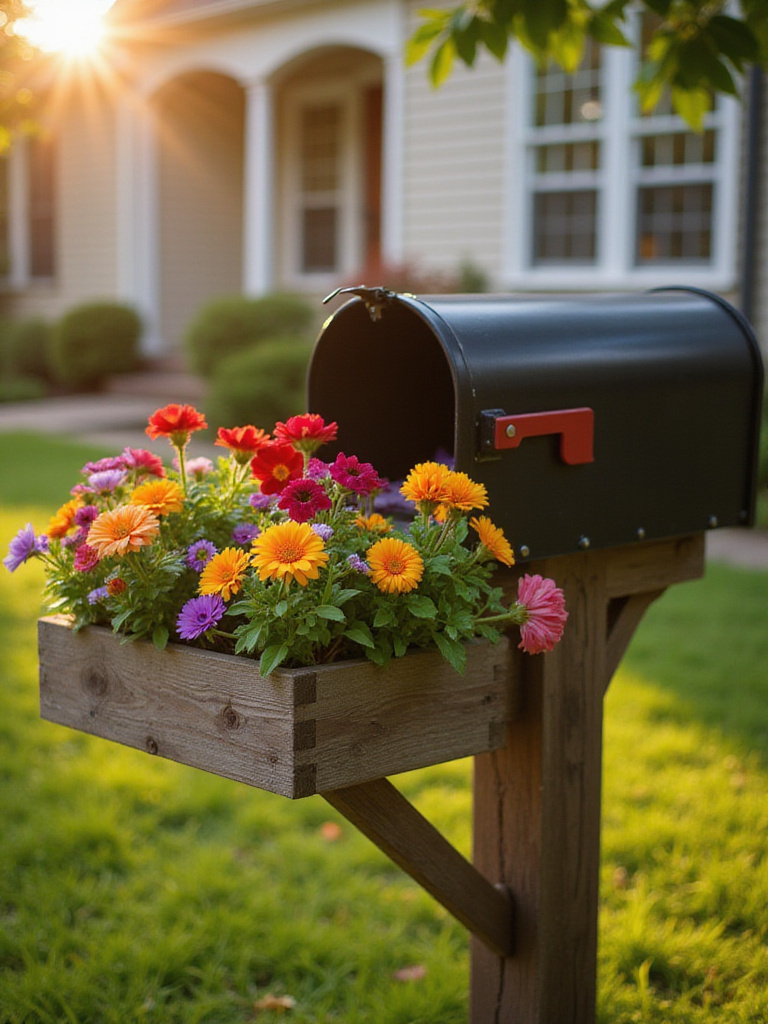
Consider your mailbox as an opportunity to express design continuity, using materials and forms that relate to your home’s architecture. The area surrounding it can become a miniature garden vignette, perhaps featuring seasonal plantings or a small arrangement of stones. This attention to detail demonstrates care that extends to every aspect of your landscape.
- Select a mailbox design that complements architectural elements of your home
- Create a small but complete plant composition surrounding the mailbox
- Consider how this area appears when viewed from different approaches
The care shown in these small details naturally extends to the vertical dimension of your front yard landscaping, where climbing plants can transform walls and structures.
12. Create Living Architecture with Vertical Elements
vertical gardening introduces dimension to front yard landscaping that engages the eye upward, making even modest spaces feel more expansive. In Japanese garden design, the relationship between horizontal and vertical elements creates balance—neither dominating but each complementing the other.
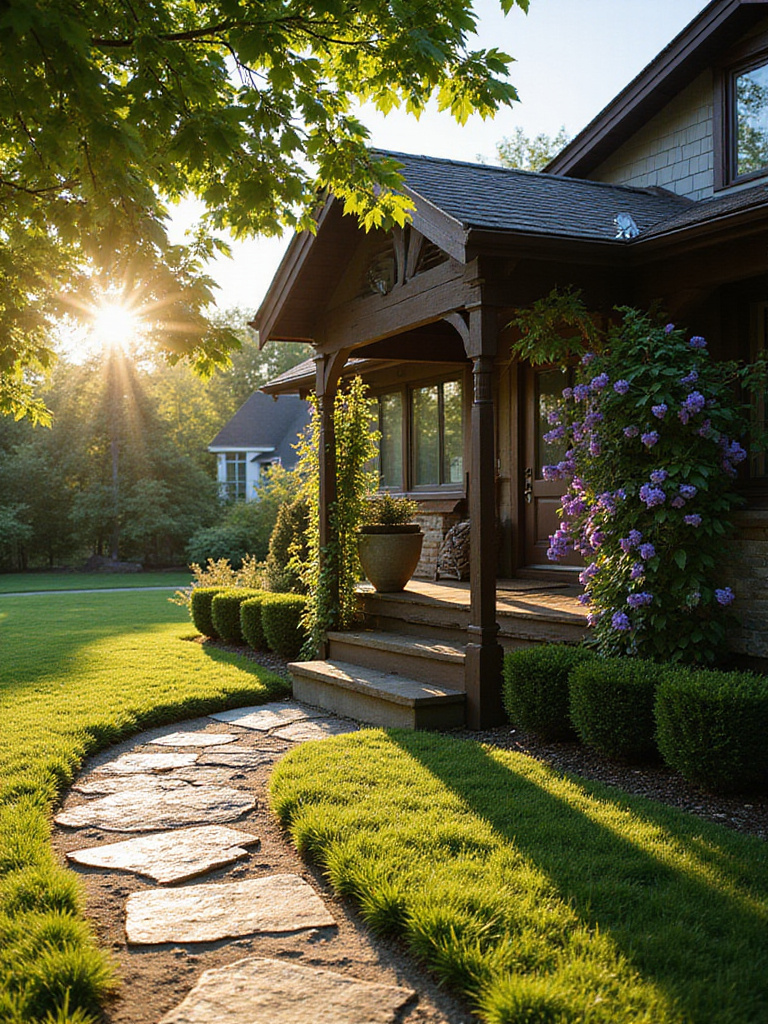
Trellises and climbing plants transform blank walls into living tapestries that change with seasons. Consider how these vertical elements frame views or create Privacy Screens where needed. The structure itself can be either prominently designed or nearly invisible beneath foliage, depending on your aesthetic preference.
- Train climbing hydrangea or Japanese climbing hydrangea for north-facing walls
- Use bamboo or weathered wood trellises that develop character with age
- Consider espaliered fruit trees for both ornamental value and harvest
The vertical dimension created by these elements complements the horizontal plane, where thoughtful ground treatment enhances both aesthetics and plant health.
13. Nurture Soil Health Through Mindful Mulching
Mulch represents more than mere decoration in thoughtful front yard landscaping—it mimics the natural forest floor where organic materials continuously decompose to nourish soil life. This practice honors the Japanese principle of working with natural cycles rather than against them.
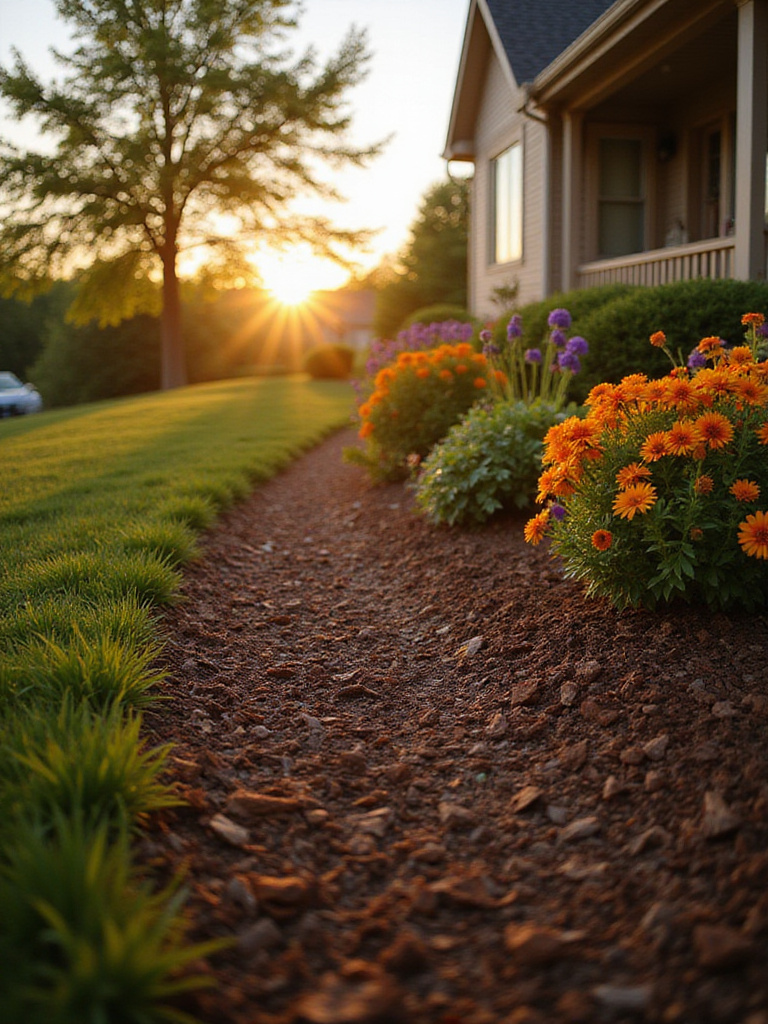
Choose mulch materials that complement your aesthetic while serving functional needs. In more naturalistic designs, partially decomposed leaves create an authentic woodland feel, while more formal settings might require a more processed appearance. The goal remains consistent—protecting soil, retaining moisture, suppressing weeds, and gradually enriching the soil ecosystem.
- Use partially decomposed leaf mulch in woodland-inspired gardens
- Consider crushed shell or fine gravel for Mediterranean or coastal aesthetics
- Maintain proper depth (2-3 inches) without mounding against plant stems
The nurturing layer of mulch creates a foundation for another element that guides movement through the landscape—thoughtfully placed stepping stones.
14. Guide Contemplative Movement with Stone Pathways
Stepping stones create moments of mindfulness in front yard landscaping, encouraging deliberate placement of feet and awareness of surroundings. The Japanese garden tradition uses these elements to slow movement and focus attention on the journey rather than merely the destination.
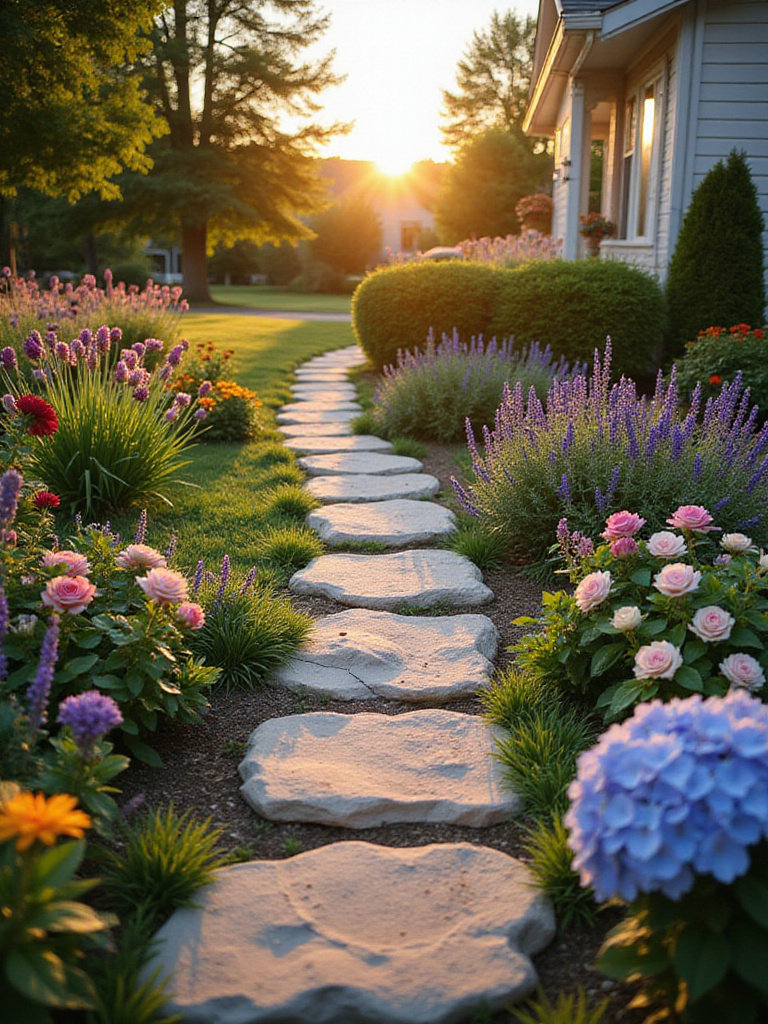
Space stones at a comfortable walking pace, considering the natural stride of those who will use them. Their placement can create rhythm through consistent spacing or introduce moments of pause through varied distances. The stones themselves might be uniform for a more formal appearance or irregular for naturalistic settings, but each should offer stable footing and visual relationship to its neighbors.
- Set stones slightly above grade to shed water and prevent settling
- Consider how stones appear in rain, perhaps selecting materials that reveal hidden colors when wet
- Create intentional moments of choice with stones that offer alternative paths
The deliberate pace encouraged by stepping stones allows appreciation of artistic elements that might otherwise be overlooked.
15. Celebrate Focal Points Through Artistic Elements
A thoughtfully placed sculpture or artistic element can transform front yard landscaping from merely pleasant to deeply meaningful. In Japanese gardens, symbolic elements like stone lanterns or water basins serve as focal points that invite contemplation while harmonizing with natural surroundings.
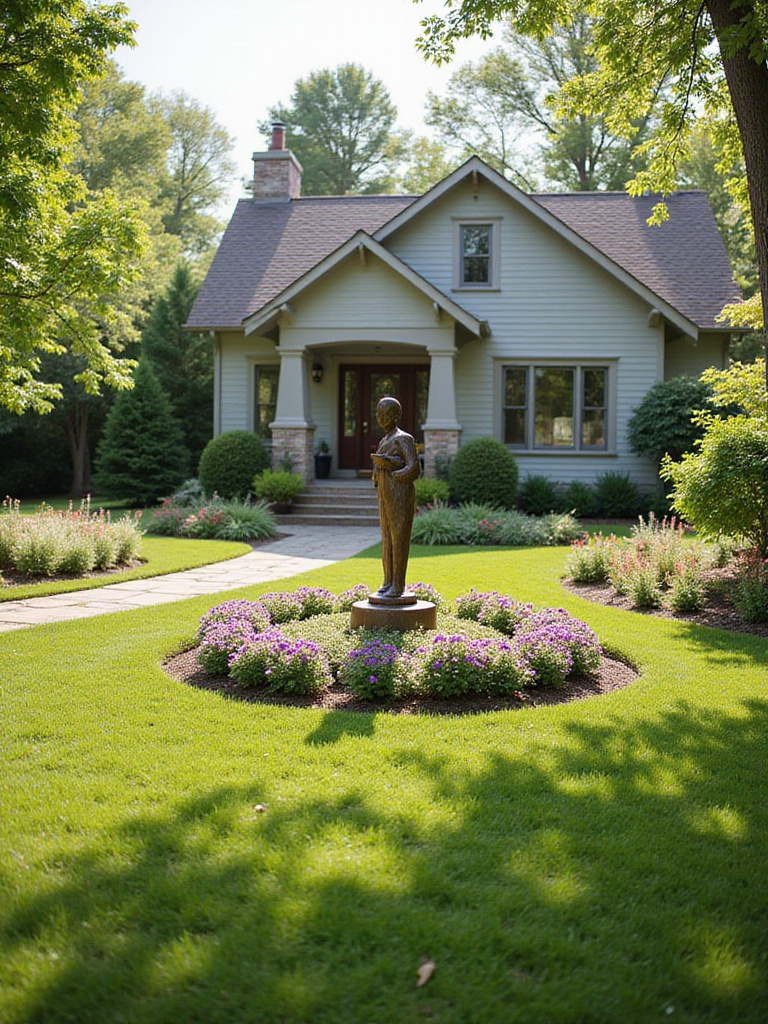
Select artistic elements that resonate with personal meaning rather than merely decorative objects. Consider how these pieces change with weather conditions, seasons, and viewing angles. Their placement should feel neither random nor artificially centered, but rather in natural relationship with surrounding elements.
- Choose materials that develop character with age—copper that patinates, stone that gathers moss
- Consider how the piece catches light at different times of day
- Place art where it can be appreciated from both pathways and windows
“Art in the garden should appear to have always been there, as if nature herself had placed it.”
The artistic focal point creates a center of interest that complements another sensory dimension of front yard landscaping—fragrance.
16. Engage Multiple Senses with Aromatic Plants
Fragrance adds an invisible but powerful dimension to front yard landscaping, creating sensory memories and emotional connections that visual elements alone cannot achieve. The Japanese garden tradition honors all senses, recognizing that complete experience emerges from this holistic approach.
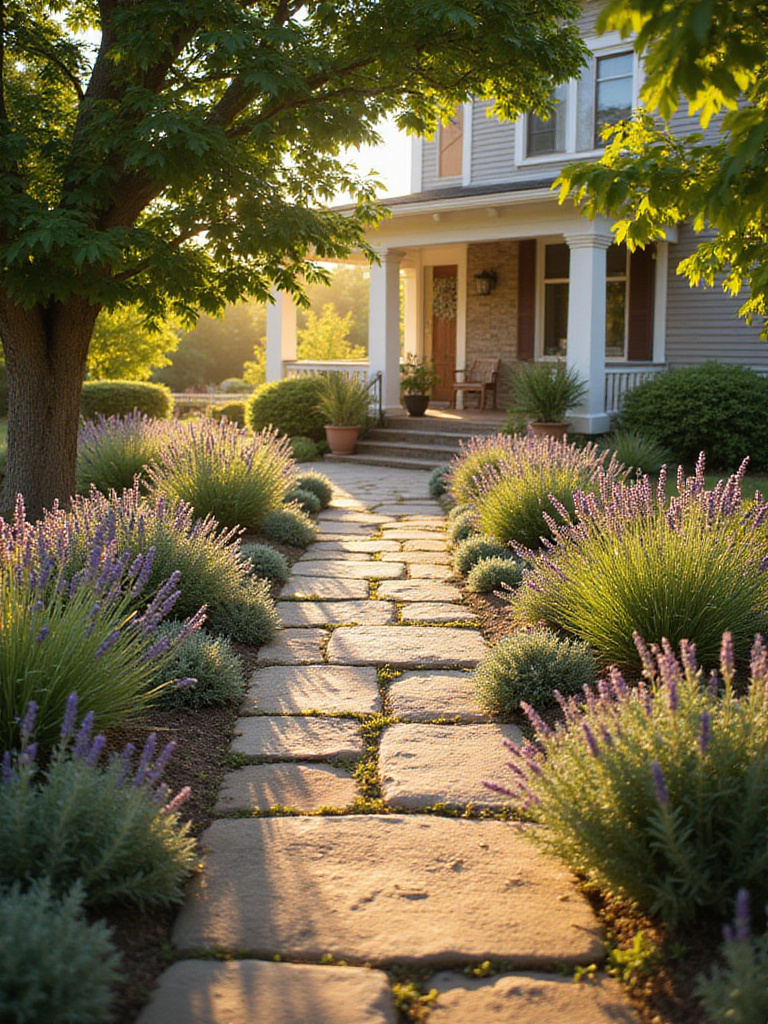
Position aromatic plants where their scents will be appreciated—near walkways, entries, or seating areas where people naturally pause. Consider the timing of fragrance—some plants release scent in morning sunshine, others in evening humidity, and some only when touched or brushed against. This temporal quality adds another layer of discovery to your landscape.
- Plant herbs like rosemary or lavender along paths where they’ll be brushed in passing
- Consider night-scented plants near seating areas used in evening
- Include plants with aromatic foliage for scent even when not in bloom
The sensory richness of fragrant plants naturally complements another aspect of thoughtful front yard landscaping—harmony with the local ecosystem.
17. Practice Shizen Through Native Plant Communities
Working with rather than against nature honors the Japanese principle of shizen—allowing natural processes to express themselves within a framework of human intention. In front yard landscaping, this translates to embracing native plant communities that have evolved together over millennia.
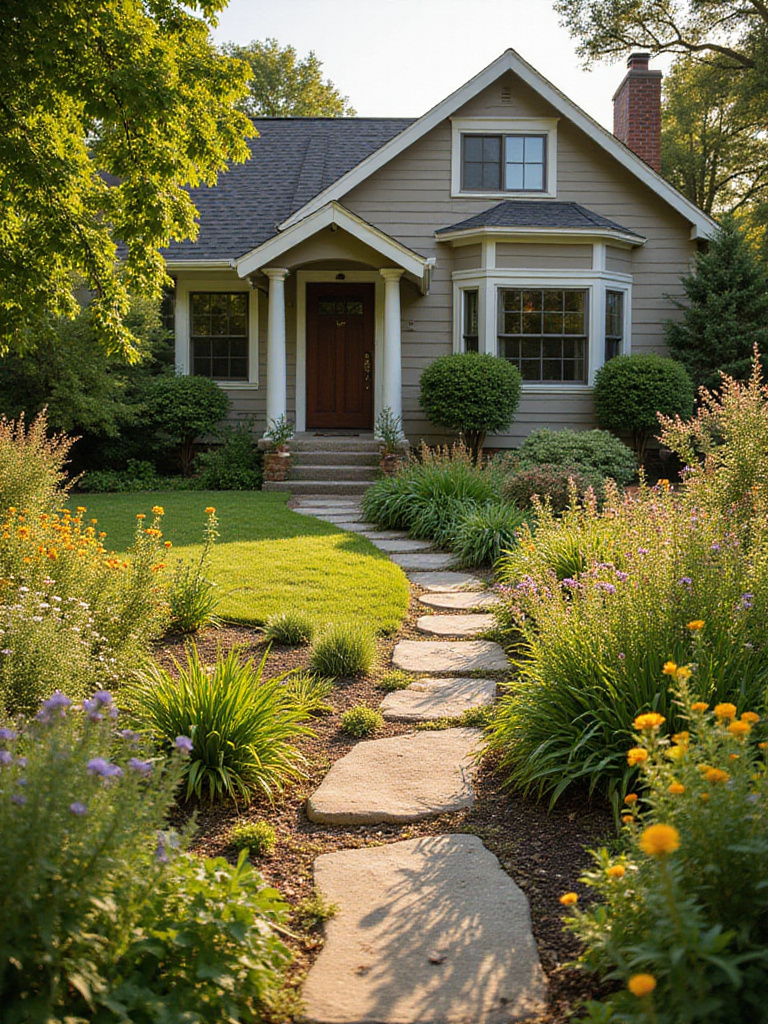
Select native plants not as isolated specimens but as communities with natural relationships. Consider how these plants interact in wild settings—which grow as understory beneath trees, which form groundcover, which emerge as seasonal accents. This approach creates gardens that feel deeply rooted in place rather than imposed upon it.
- Group plants according to their natural associations and requirements
- Include plants that support local wildlife through berries, seeds, or habitat
- Consider the seasonal rhythms of native plant communities in your design
The ecological harmony created by native plantings naturally extends to the flexibility offered by container gardens.
18. Embrace Flexibility Through Container Compositions
Container gardens introduce an element of adaptability to front yard landscaping, allowing seasonal changes and experimental compositions without permanent commitment. This approach honors the Japanese concept of temporality—acknowledging that gardens, like life itself, are always in transition.
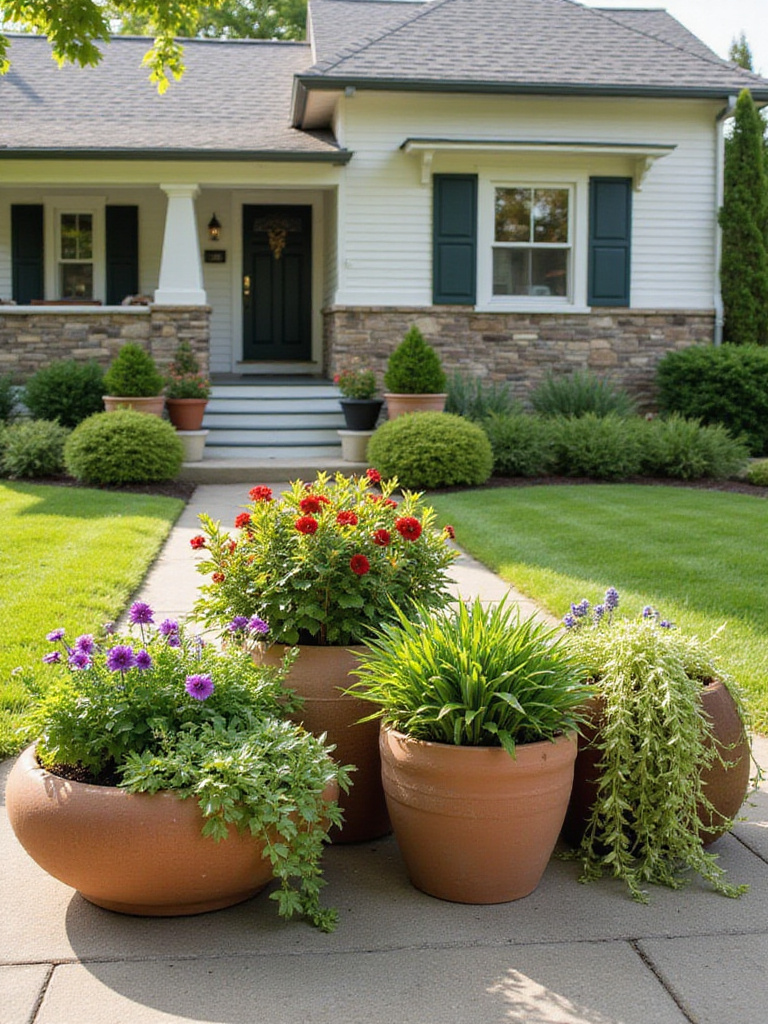
Select containers that complement your home’s architecture while providing proper conditions for plants. Consider grouping containers of varying heights to create more complex compositions rather than isolated specimens. Their placement should respond to both aesthetic considerations and practical needs of the plants they contain.
- Use large containers for greater visual impact and root space
- Create container vignettes that tell a cohesive story through plant selection
- Consider how containers might mark thresholds or guide movement through space
The flexibility of container gardens complements another aspect of responsive front yard landscaping—creating habitat for wildlife.
19. Welcome Nature’s Visitors With Habitat Gardens
A front yard landscape that welcomes birds, butterflies, and beneficial insects creates a living, dynamic environment that changes moment by moment. This approach honors the Japanese principle of embracing transience and finding beauty in the ephemeral nature of life.
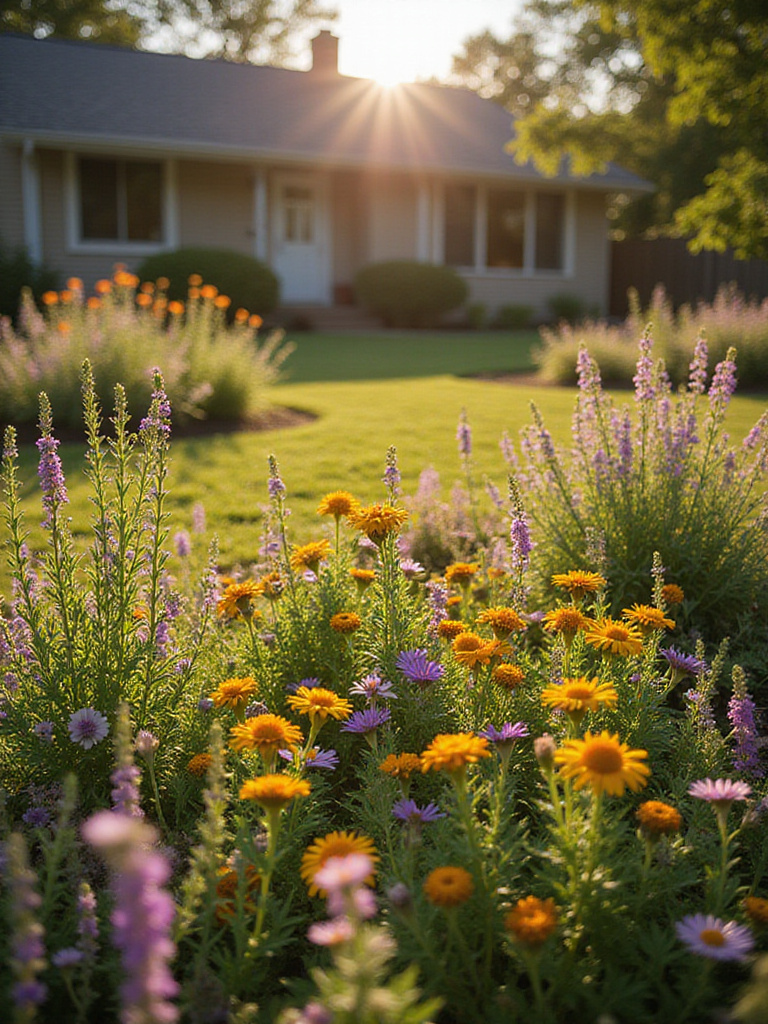
Design with the needs of wildlife in mind—water sources, food plants, shelter, and nesting sites. Consider the complete lifecycle of visitors like butterflies, providing both nectar sources for adults and host plants for larvae. The resulting garden becomes not just a static picture but a constantly evolving ecosystem with daily surprises.
- Include water sources at various heights for different creatures
- Plant in drifts to make food sources more visible to pollinators
- Incorporate brush piles or decorative insect hotels for beneficial insects
“The garden that welcomes wildlife is never the same twice—each visit reveals new interactions and relationships.”
The dynamic nature of wildlife-friendly front yard landscaping contrasts with the need to thoughtfully address permanent utilitarian elements.
20. Practice Concealment and Revelation in Utility Areas
Even the most practical elements of front yard landscaping deserve thoughtful treatment. The Japanese principle of miegakure—”hide and reveal”—offers guidance for handling necessary but potentially unsightly features like utility boxes or air conditioning units.
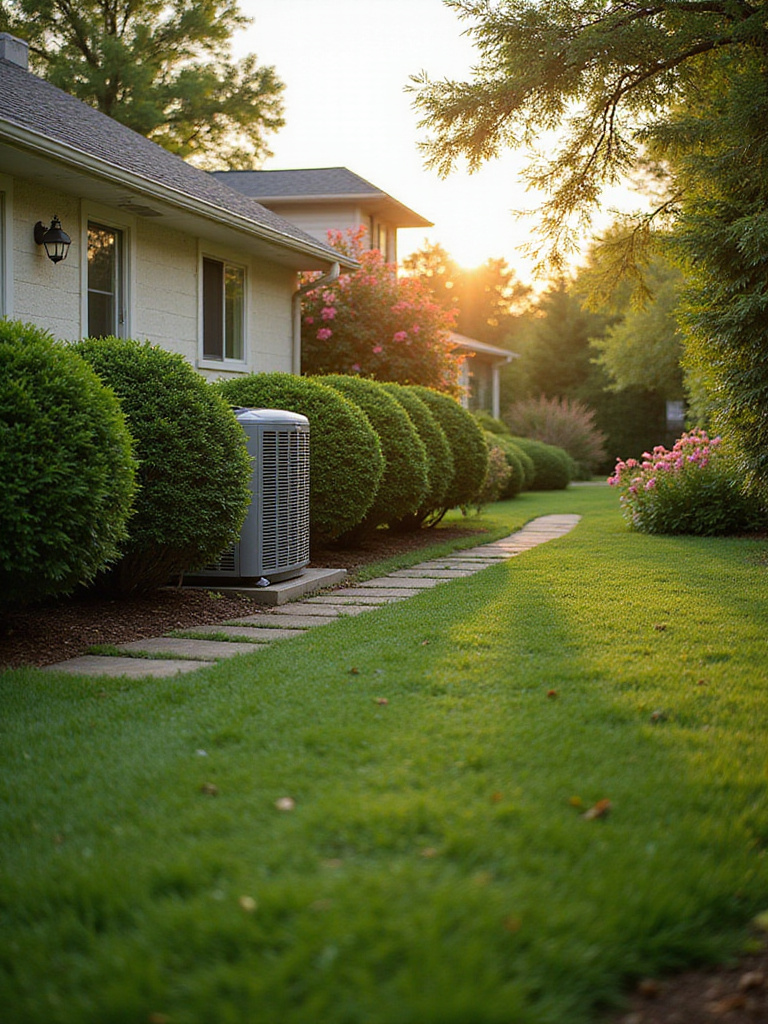
Rather than attempting to completely hide these elements (which often draws more attention to them), consider partial screening that integrates them into the overall design. A thoughtfully placed shrub, decorative panel, or small structure can redirect attention while maintaining necessary access for maintenance.
- Use decorative screens with patterns that complement architectural details
- Plant grasses or shrubs that provide seasonal screening without becoming obstacles
- Consider how utility areas appear from different viewpoints, including from inside the home
The thoughtful integration of practical elements complements another aspect of welcoming front yard landscaping—creating habitat for birds.
21. Honor Transience Through Bird-Friendly Features
Bird baths and feeders introduce an element of animation and unpredictability to front yard landscaping. The Japanese aesthetic principle of appreciating the transient and ephemeral finds perfect expression in these features that attract fleeting visitors.
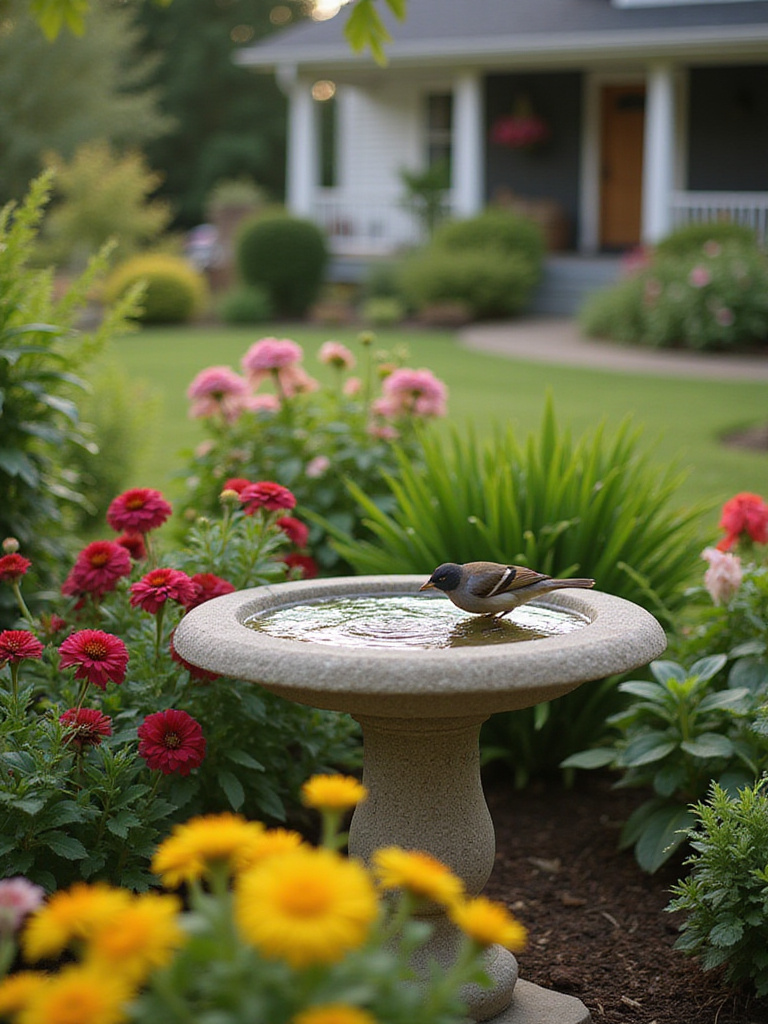
Position bird-friendly elements where they can be appreciated from both outdoor seating areas and indoor viewing points like kitchen windows. Consider the surrounding plantings that provide perching spots, protective cover, and natural food sources. The sound of birdsong adds another sensory dimension to your landscape experience.
- Place bird baths where cats cannot easily ambush visitors
- Consider heated bird baths for winter use in cold climates
- Include plants with seedheads that provide natural food sources
The lively presence of birds creates a natural complement to defined human gathering spaces in front yard landscaping.
22. Balance Public and Private Through Thoughtful Gathering Spaces
A front yard patio represents a philosophical choice about the relationship between private life and community. Unlike backyard spaces that are fully private, front gathering areas exist in dialogue with the neighborhood—visible yet defined, welcoming yet bounded.
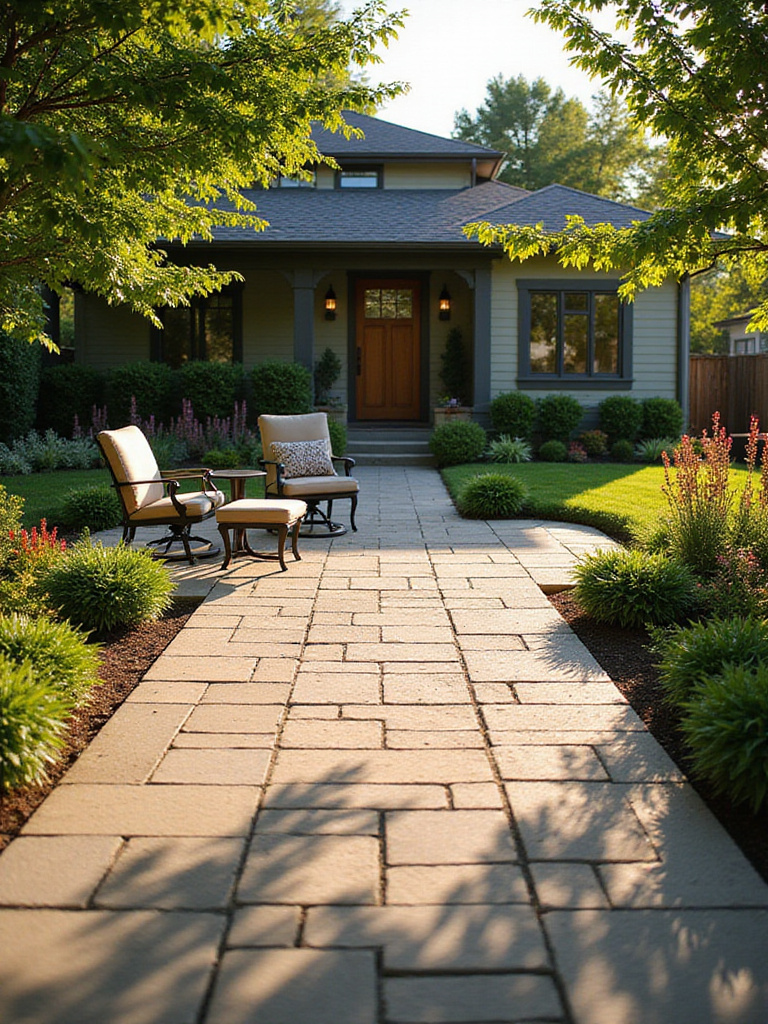
Design these spaces with careful consideration of both comfort and context. The degree of enclosure should reflect your desired balance between privacy and connection. Materials should harmonize with both your home’s architecture and the surrounding landscape elements. Consider how the space will be used throughout the day and across seasons.
- Create partial enclosure with plantings rather than solid barriers
- Position seating to offer views both inward toward your home and outward to the landscape
- Consider how the space transitions between public sidewalk and private entrance
The thoughtful balance between public and private spaces naturally leads to consideration of how different elements relate to create a cohesive whole in front yard landscaping.
23. Create Visual Harmony Through Layered Compositions
Layered plantings honor the Japanese principle of miyabi—refined elegance that emerges from thoughtful composition. In front yard landscaping, this approach creates depth and visual interest through careful arrangement of plants with varying heights, textures, and seasonal presence.
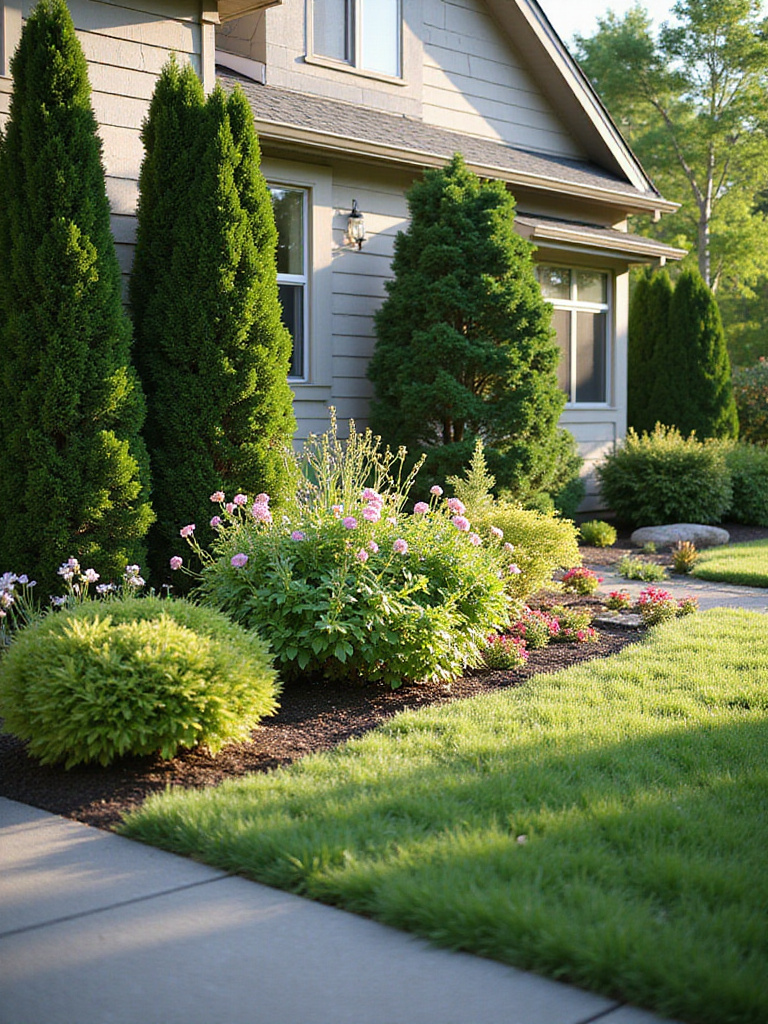
Consider the landscape as a three-dimensional composition that changes not just through seasons but through years as plants mature. The relationship between fast-growing perennials and slower-developing shrubs creates a landscape that evolves over time, revealing new relationships and focal points as it matures.
- Plant in drifts rather than isolated specimens for more natural-appearing groupings
- Create visual movement through repetition of key plants at different points in the landscape
- Consider how winter structure maintains interest when deciduous plants are dormant
The compositional harmony of layered plantings provides a framework within which the simple beauty of a well-maintained lawn can shine.
24. Practice Mindful Maintenance for Enduring Beauty
The most thoughtfully designed front yard landscaping requires consistent care to fulfill its potential. The Japanese concept of kodawari—an uncompromising attention to detail—finds expression in regular maintenance that respects each element’s nature and purpose.
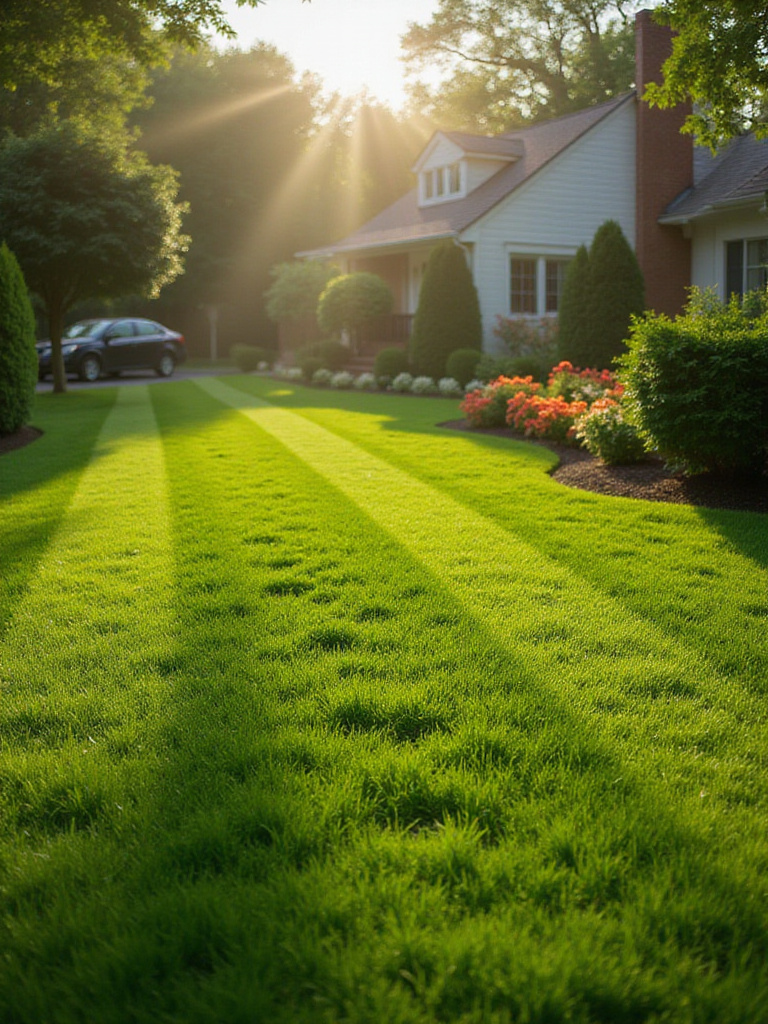
Approach maintenance not as a battle against nature but as an ongoing dialogue. Pruning should enhance a plant’s natural character rather than force it into unnatural forms. Lawn care should focus on soil health rather than merely surface appearance. Each maintenance task becomes an opportunity to observe closely and respond appropriately to changing conditions.
- Develop seasonal maintenance routines that anticipate rather than react to problems
- Consider the sound of maintenance tools—hand tools often allow more mindful work than power equipment
- View maintenance as a form of meditation and connection with your landscape
- Practice “right plant, right place” principles to reduce unnecessary intervention
- Learn proper pruning techniques specific to each plant type
- Consider how maintenance practices affect wildlife and beneficial organisms
View maintenance as a form of meditation and connection with your landscape
Practice “right plant, right place” principles to reduce unnecessary intervention
Finding Balance in Front Yard Landscaping
The journey through these 24 front yard landscaping ideas reveals a common thread—the search for balance between human intention and natural processes, between aesthetic pleasure and ecological function, between tradition and personal expression. Like the Japanese concept of wabi-sabi, the most satisfying landscapes embrace imperfection and transience rather than fighting against them.
As you consider your own front yard transformation, remember that true harmony emerges not from rigid adherence to rules but from thoughtful response to the unique conditions of your site. The most successful front yard landscaping speaks not just of current trends but of deeper connections—to place, to natural cycles, and to the daily experience of arriving home.
The space between sidewalk and threshold offers a rare opportunity to create something that serves both private joy and public beauty. In this liminal zone, your values and aesthetic sensibilities become visible to all who pass by. What story will your front yard tell?
